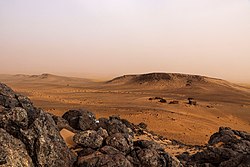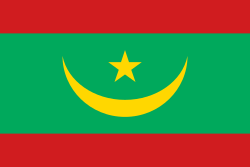Oko Sahary
| Oko Sahary | |
|---|---|
 | |
| Podřazené jednotky | Hofrat Ouadane |
| Stát | |
| Souřadnice | 21°7′26″ s. š., 11°24′7″ z. d. |
| Některá data mohou pocházet z datové položky. | |


Oko Sahary (arabsky قلب الريشات , Qalb ar-Rīšāt; s vědeckým názvem Richatská struktura) je rozlehlá kruhová struktura v Mauretánii, dobře patrná při pohledu z vesmíru, rozkládající se v saharské poušti na hranici regionů Adrar a Tiris Zemmour nedaleko města Ouadane. Ríšat má průměr přibližně 50 km a skládá se z několika soustředných kruhů. Nejedná se o impaktní kráter. Podle výzkumů se jedná o geologický dóm. Vedou se spory, jak celá struktura vznikla.[1] Objevila se i okrajová teorie, že Oko Sahary je ve skutečnosti pozůstatkem kdysi zničené bájné Atlantidy.[nenalezeno v uvedeném zdroji][2]
Odkazy
Reference
- ↑ MRZENA, Tomáš. Jak vzniklo tajemné oko Sahary: Jedná se o starou základnu mimozemšťanů?. deník.cz [online]. 2018-02-26 [cit. 2018-02-26]. Dostupné online.
- ↑ Youtube.com - Ztracené město Atlantida a Oko Sahary
Externí odkazy
 Obrázky, zvuky či videa k tématu Oko Sahary na Wikimedia Commons
Obrázky, zvuky či videa k tématu Oko Sahary na Wikimedia Commons
Média použitá na této stránce
Flag of Mauritania, adopted in 2017. The National Assembly added red stripes to the top and bottom edges to represent “the blood shed by the martyrs of independence”.
Autor: Liu, X.-Y.; Li, A.-B.; Chen, H.; Men, Y.-Q.; Huang, Y.-L, Licence: CC BY 4.0
Diagram of the Richat structure
The Richat Structure of Mauritania has captured the attention of astronauts for about as long as NASA has sent humans into orbit around Earth. This circular geologic feature is thought to be caused by an uplifted dome—geologists would classify it as a domed anticline—that has been eroded to expose the originally flat rock layers.
In this type of geologic structure, rocks exposed in the center of the “bullseye” are older than rocks forming the outer rings. This structure measures 45 kilometers (28 miles) across and is made up of igneous and sedimentary rocks. There are several faults visible (lower left) where strata that were once continuous have been shifted apart.
Most of Mauritania lies within the Sahara Desert, where dry climate conditions and periodic droughts create difficult living conditions. Approximately 3.7 million people live in Mauritania, though much of the population lives along its Atlantic coastline, about 500 kilometers (300 miles) from the Richat Structure.
Astronaut photograph ISS030-E-12516 was acquired on December 17, 2011, with a Nikon D2Xs digital camera using a 400 millimeter lens and is provided by the ISS Crew Earth Observations Facility and the Earth Science and Remote Sensing Unit, Johnson Space Center. The image was taken by a member of the Expedition 30 crew. The image has been cropped and enhanced to improve contrast, and lens artifacts have been removed. The International Space Station Program supports the laboratory as part of the ISS National Lab to help astronauts take pictures of Earth that will be of the greatest value to scientists and the public, and to make those images freely available on the Internet. Additional images taken by astronauts and cosmonauts can be viewed at the NASA/JSC Gateway to Astronaut Photography of Earth. Caption by Andrea Meado, Jacobs Technology, JETS Contract at NASA-JSC.


